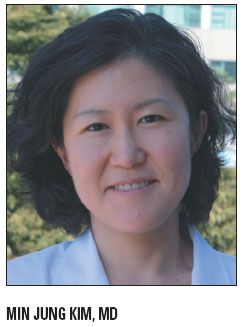Ultrasound targets lymph node recurrence in breast cancer
Ultrasound is an effective way to monitor lymph node recurrence after breast cancer surgery, South Korean researchers reported. Regional lymph node recurrence affects just 2% to 16% of patients with any stage of breast cancer, but is difficult to manage and associated with poor prognosis.
Ultrasound is an effective way to monitor lymph node recurrence after breast cancer surgery, South Korean researchers reported. Regional lymph node recurrence affects just 2% to 16% of patients with any stage of breast cancer, but is difficult to manage and associated with poor prognosis.

Lymph node recurrence (LNR) detection remains challenging. Physical exams result in a high false-negative rate (39%), and mammography’s field-of-view doesn’t cover the entire axilla. One version, supraclavicular LNR, is associated with concurrent or subsequent distant metastasis.
The Korean study included 1,817 patients, all imaged with ultrasound. Thirty-nine of them (2.1%) had LNR; for 11 of them the LNR was ipsilateral. Nine lesions were palpable (Radiol 252:673-681, 2009).
The LNR findings were confirmed by cytopathologic results, clinical follow-up, and other imaging studies (CT, MRI, or FDG-PET). Ultrasound sensitivity was 76.9% and specificity was 98.7%. Distant metastases were found more frequently in patients with ipsilateral LNR (62%) than in those without (2.3%).
“On the basis of this result, imaging surveillance for distant metastases should be performed when ipsilateral LNR is detected at screening ultrasound,” wrote Hee Jung Moon, MD, Min Jung Kim, MD, and colleagues from the Research Institute of Radiological Science in Seoul, South Korea.
In Korea, ultrasound examinations of the bilateral axillary and supraclavicular lymph node areas are routinely included for patients with a history of mastectomy or breast conservation therapy. A clinical exam is performed every six months for the two to three years after such procedures and annually thereafter.
VANTAGE POINT
Asymptomatic patients may gain from ultrasound
Standard practice in the U.S. at this time is not to monitor for lymph node recurrence in asymptomatic patients with ultrasound, according to Dr. Kuzmiak, an associate professor of radiology at the Lineberger Comprehensive Cancer Center, University of North Carolina in Chapel Hill. “The yield for ultrasound is extremely low for lymph node recurrence, which limits the value of this study.”
Currently, most patients in the U.S. undergo sentinel lymph node sampling, she explained. If the sample is negative, then the probability is low that there is LNR in the axilla.

But ultrasound could prove useful for asymptomatic patients, she said. “If I can find something in a patient who is asymptomatic, it will better their survival rate than if I found it after chemotherapy was initiated,” she said.
Ultrasound could prove useful for imaging LNR in the future, and this study in particular opens up the topic for further discussion in the U.S., Dr. Kuzmiak said.